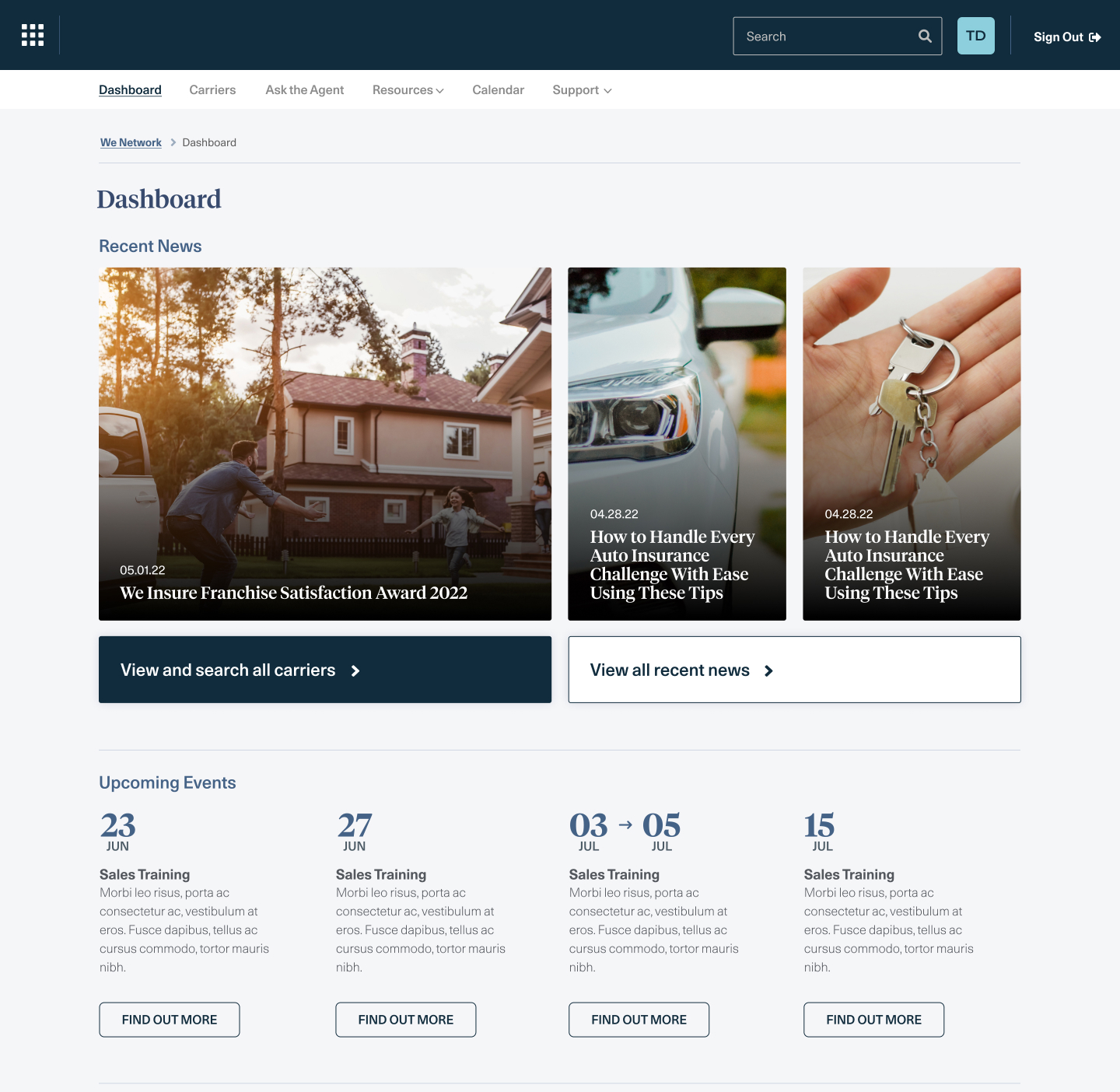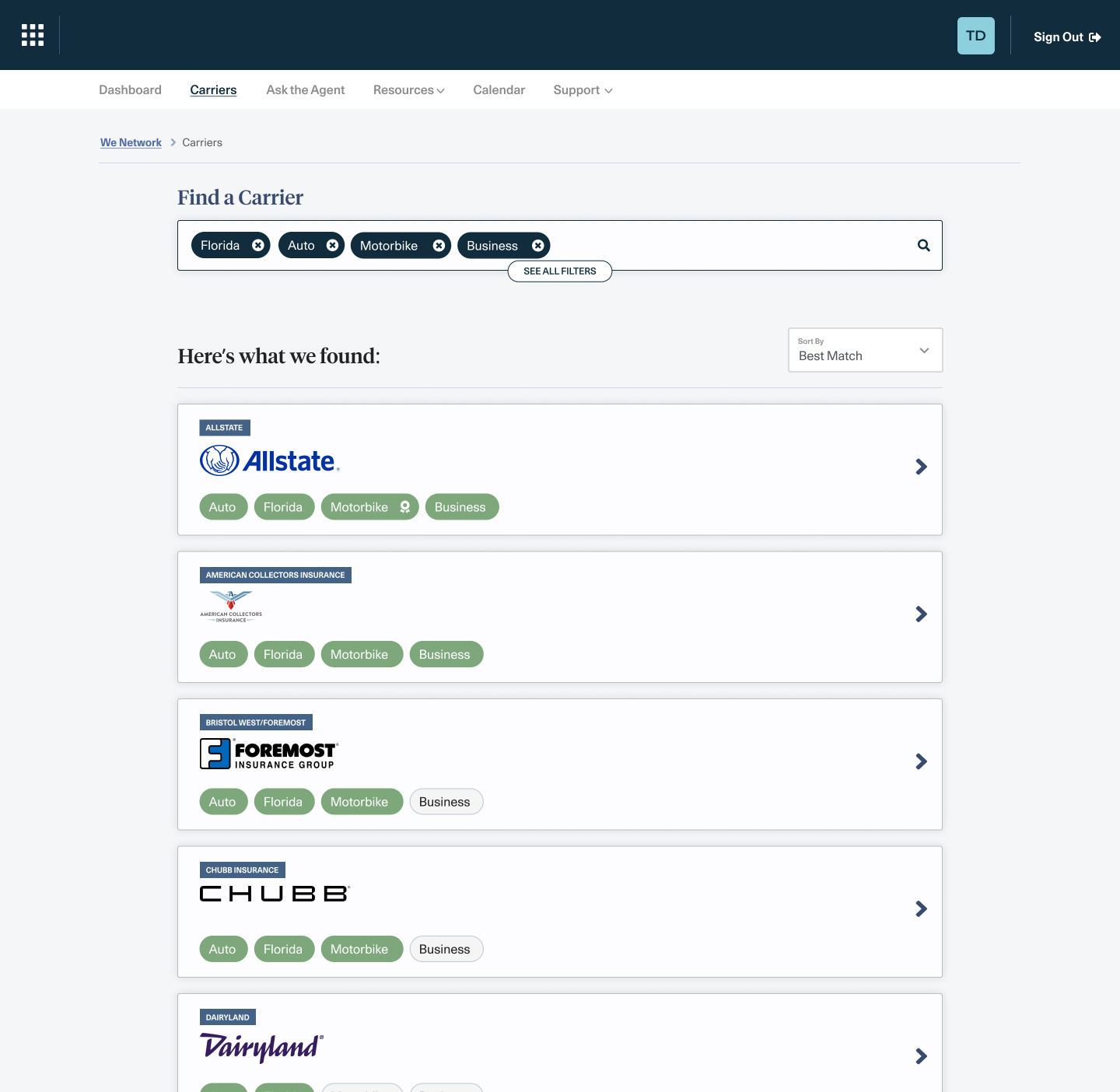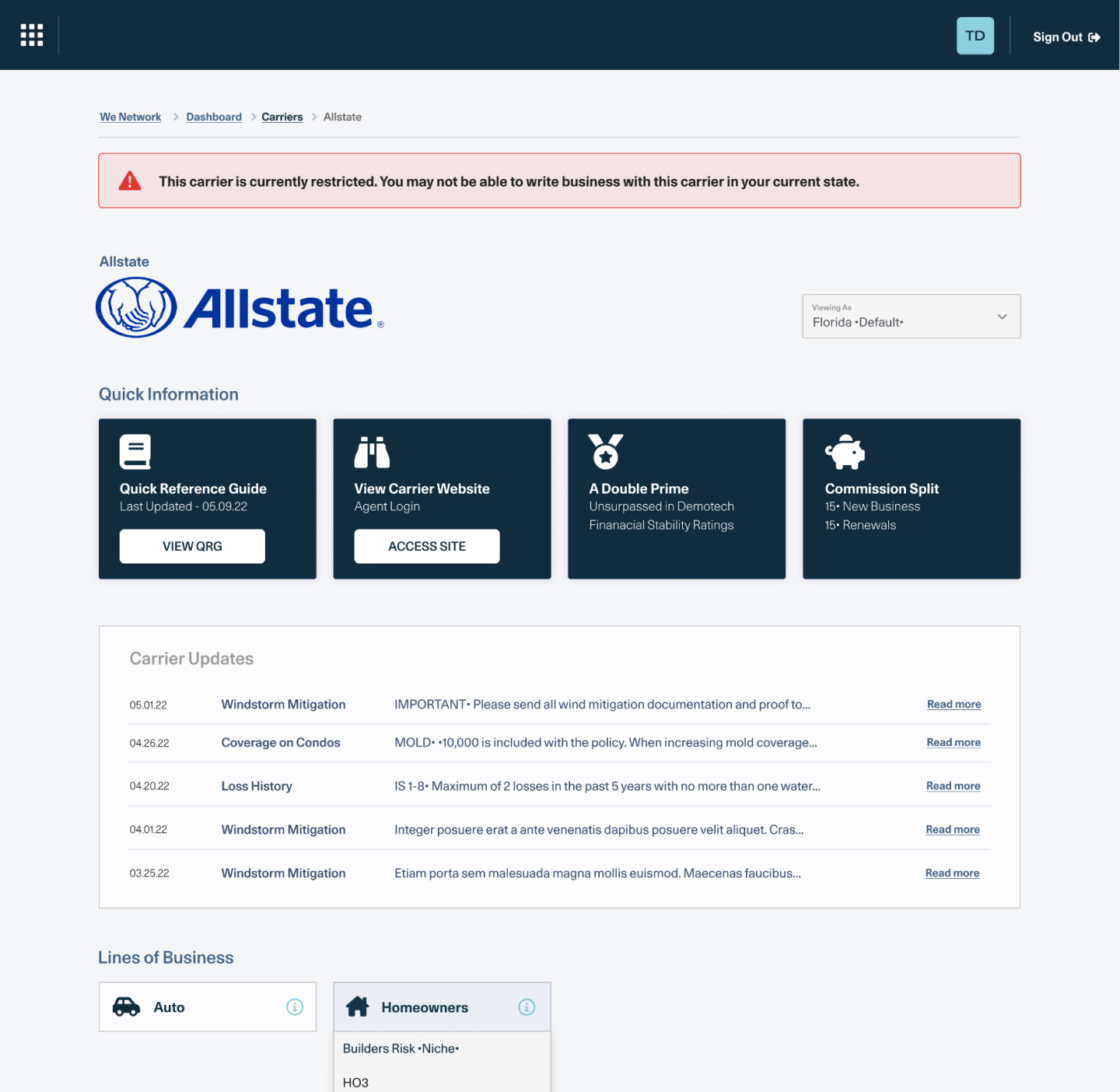Insurtech Project Deep Dive and walkthrough
Role
Project Lead
Lead UX Designer
Intro
This is a project deep dive into Phase 2 referenced in the wider case study. You can find out more about the overall engagement here. This case study is designed to reflect my process when working on a project, taking you through the various activities and tasks completed on this phase of work for the client.
In this deep dive, all logos and references to the original business have been removed and the product is simply referred to as ‘the Network’
*Please note, the final designs displayed here are not a true reflection of my current visual design skills, these are simply to help demonstrate my UX process when working on products
Context
The current process for buying insurance in the US is clunky at best. Customers are required to use brokers to purchase any sort of policy whilst brokers bridge the gap between customers and insurance carriers. The organisation leveraged technology, superior industry connections, and the foundations of an existing organisation to create a new type of insurance provider. The industry standard tools and support provided to help brokers write policies were limiting and therefore impacting revenue. At a higher level, internal processes and systems throttled the ability to scale, restricting growth of the business.
One of the main bottlenecks within the organisation is resourcing agents with the best support possible and distributing the most up-to-date industry knowledge, both from the organisation and the wider insurance industry. To date this has been done using an internal network, however this has become outdated and ignored by agents.
Helpful Terms
The organisation – The InsurTech client
Agents – Insurance brokers working for the organisation, most commonly as a franchisee or within a franchise
The network – The product being worked on in this phase of the project
Carriers – A term simply meaning insurance companies
achievements
Saved the business upwards of $4M each year
Increase of $300M of premium written annually
Agents annual commission increased by up to $150,000
Jump to Section
Empathise
Discovery
Empathise with users and stakeholders whilst defining the problems to be solved
The discovery phase creates real value and ensures success with a product or service in the future. As a key part of the process, I endeavour to facilitate discovery prior to any phases of work kicking off. This ensures any decisions made in a project are helping to solve the core problems faced by the organisation and the user, not just fixing symptoms of a deep rooted and undiscovered issue. Working as part of a multi-disciplinary team ensures a rounded perspective which results in the creation of robust solutions. The discovery phase often takes place through UX activities, workshops and research
The goals of discovery are user empathy and evidence-based understanding of needs. Defining the real problems, not the solutions. Discovery is there to answer a question or hypothesis, not to write code, build POC’s, or define solutions.
All of these considerations leads to a robust product built on research and understanding, not guesses and assumptions.
Current Implementation
Reviewing the current context of the Network
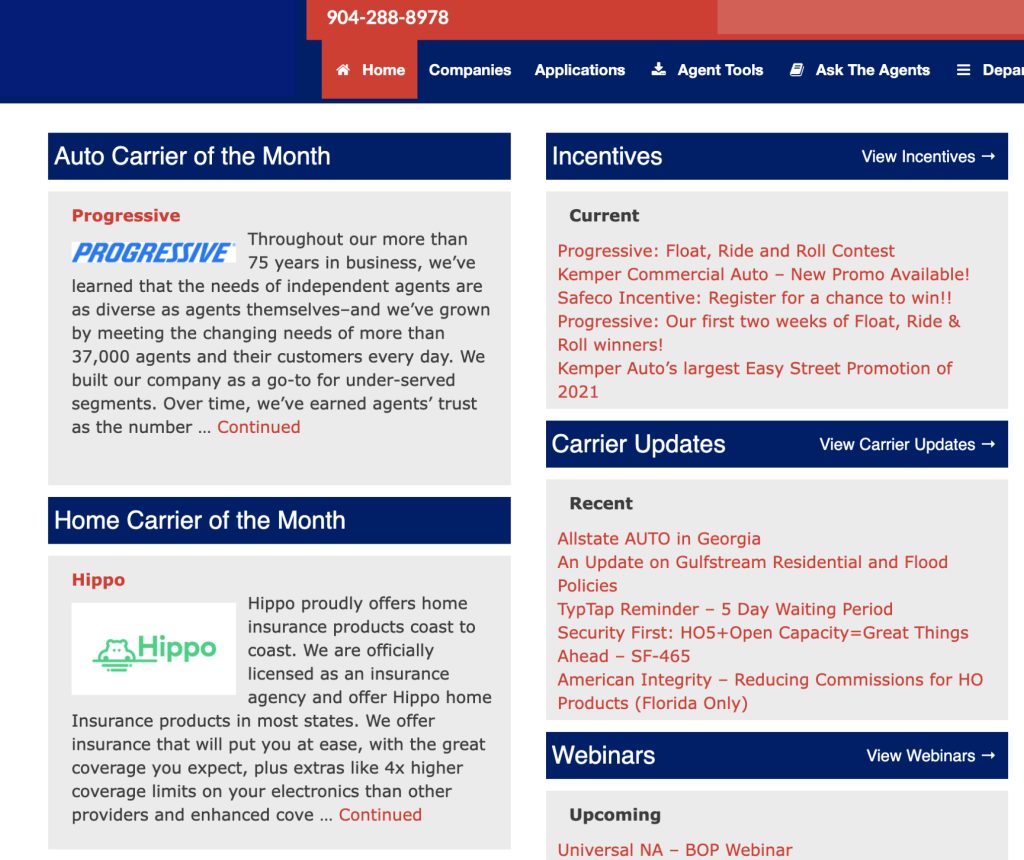
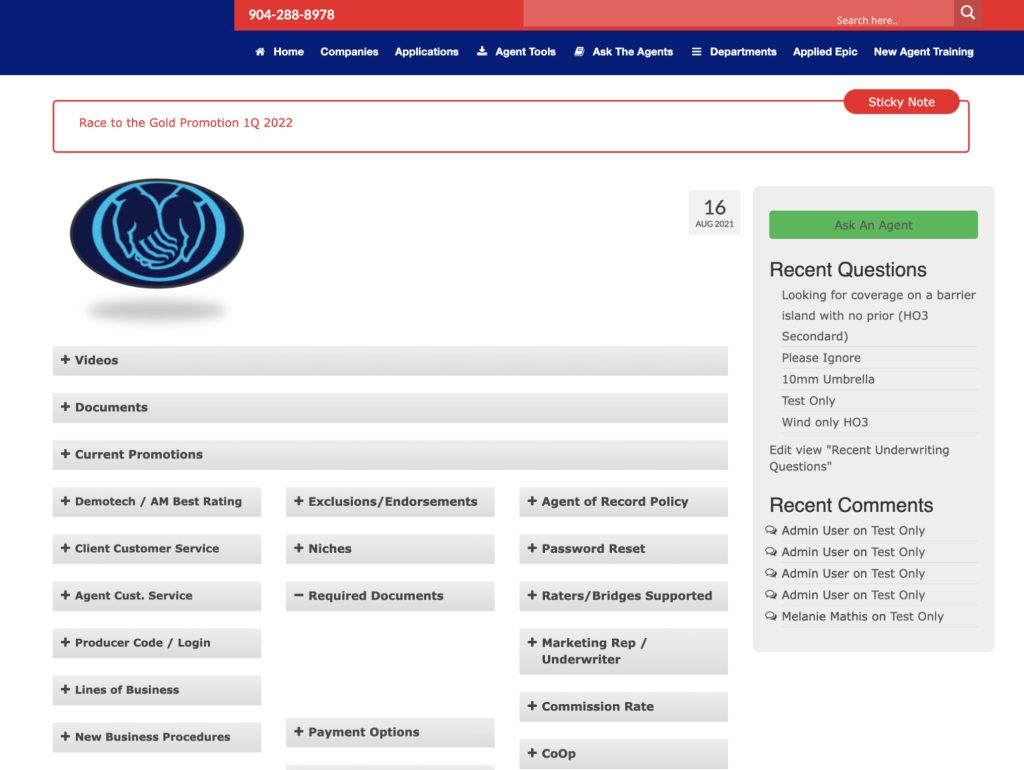
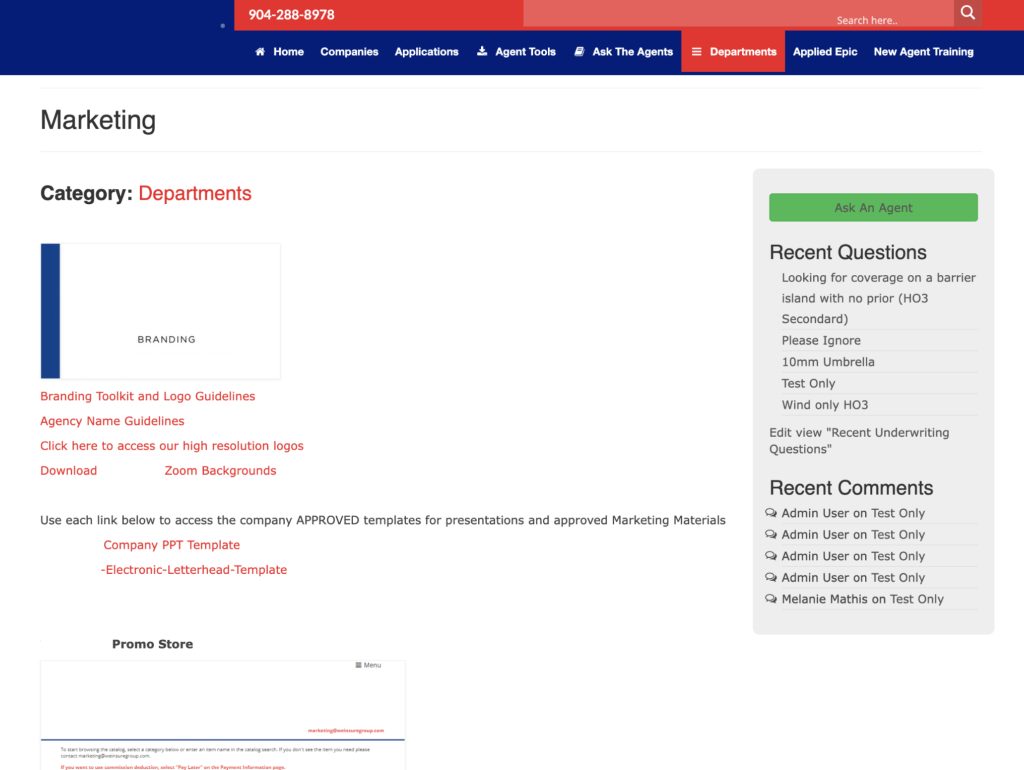
UX Analysis of the Network and Accessibility Review
Overwhelming Content: Too much shown at login; key journeys need focus
Hard-to-Find Info: Carrier details are buried and difficult to navigate
Poor Performance: Slow load times across the site
Lack of Responsiveness: Not optimised for mobile or tablet use
Structural & UX Issues: Flawed hierarchy and architecture
Accessibility Failures: Major issues with contrast, duplicated links, and screen reader compatibility
Usage Patterns: Most users access via desktop, primarily from Florida, and visit multiple carrier pages
Understanding the Numbers
Reviewing the Google Analytics over a month (Jan 14 – Feb 14)
Key Takeaways
- Majority of user journeys through the network are travelling to carrier pages, often multiple carriers in the same journey
- Currently, over 75% of current users are based in Florida and upwards of 90% of traffic visits the network via desktop
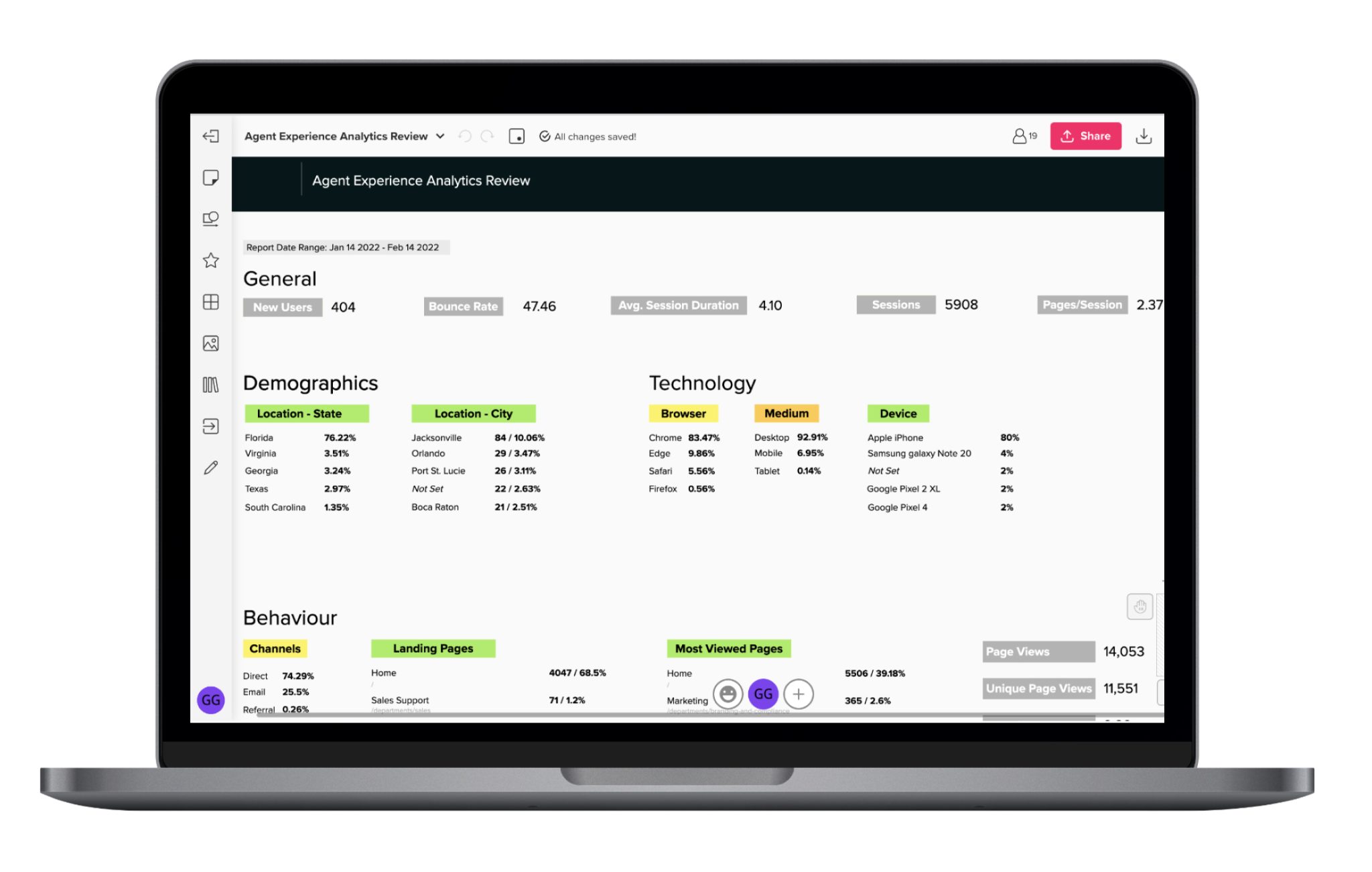
Onsite Discovery
These stats help illustrate the engagement I had when visiting with clients and users in the US. There are lot’s of in-depth details from this time but for this deep dive, I’ve chosen to focus more on the key takeaways.
1.5 Weeks in JAX + ORL
8 internal interviews from across the business
20 franchise interviews
850 miles traveled
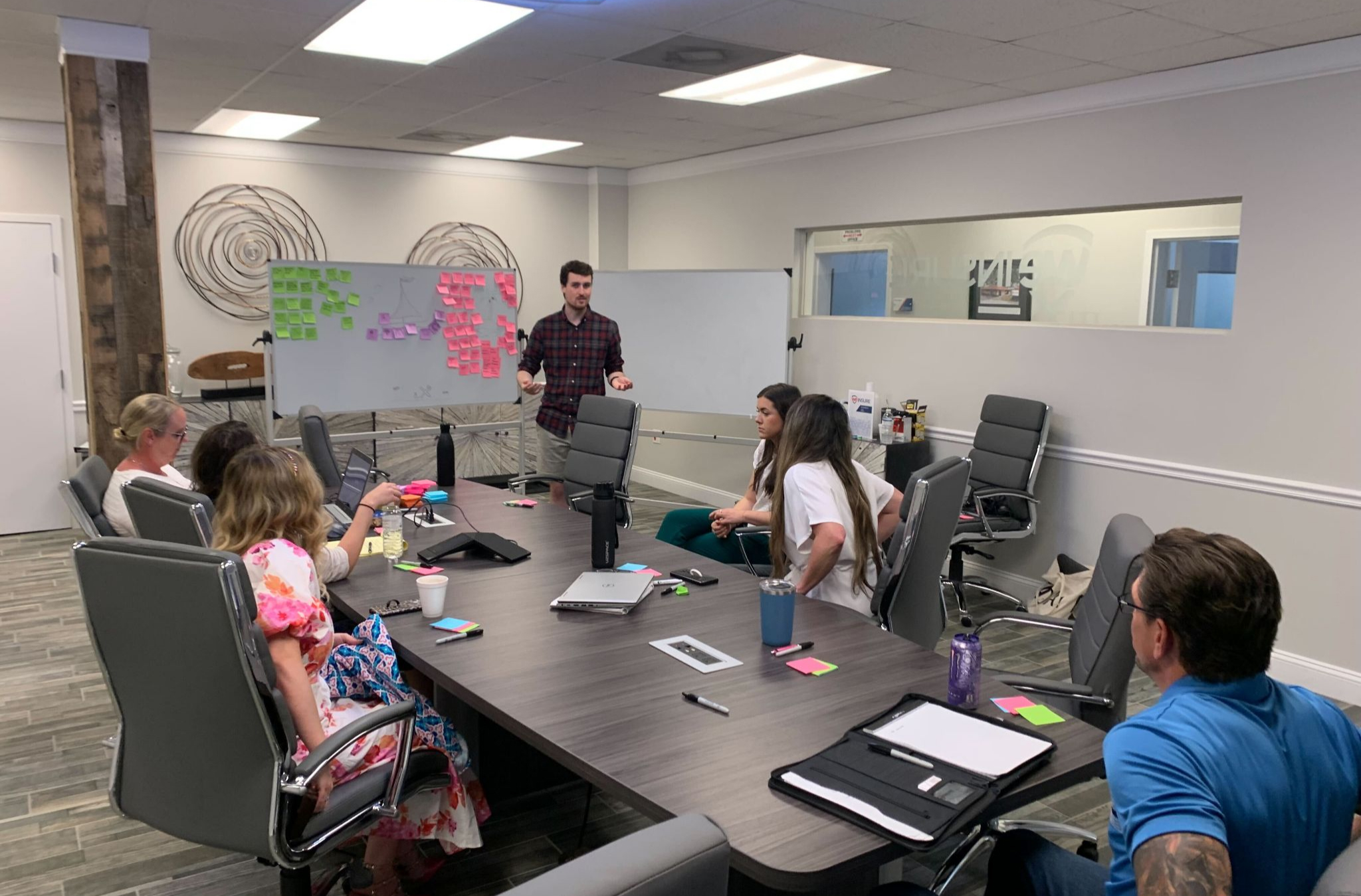
Sailboat Workshop
Aligning on internal shared goals, understanding the teams drivers and barriers
- 8 employees from various departments
- Understandings from the people on the ground
- Built a very motivated team
- Evidence by the number of buds, people were engaged in the session to make things better
- Often find more thorns when completing this workshop
Key Takeaways
- Prioritise Access: Users must efficiently reach the right carriers with accurate, contextual info
- Communication Gaps: Poor carrier communication leads to unreliable data
- Disorganised Resources: Information is scattered and unhelpful for users
- Manual Strain: Lack of automation puts excessive pressure on human resources
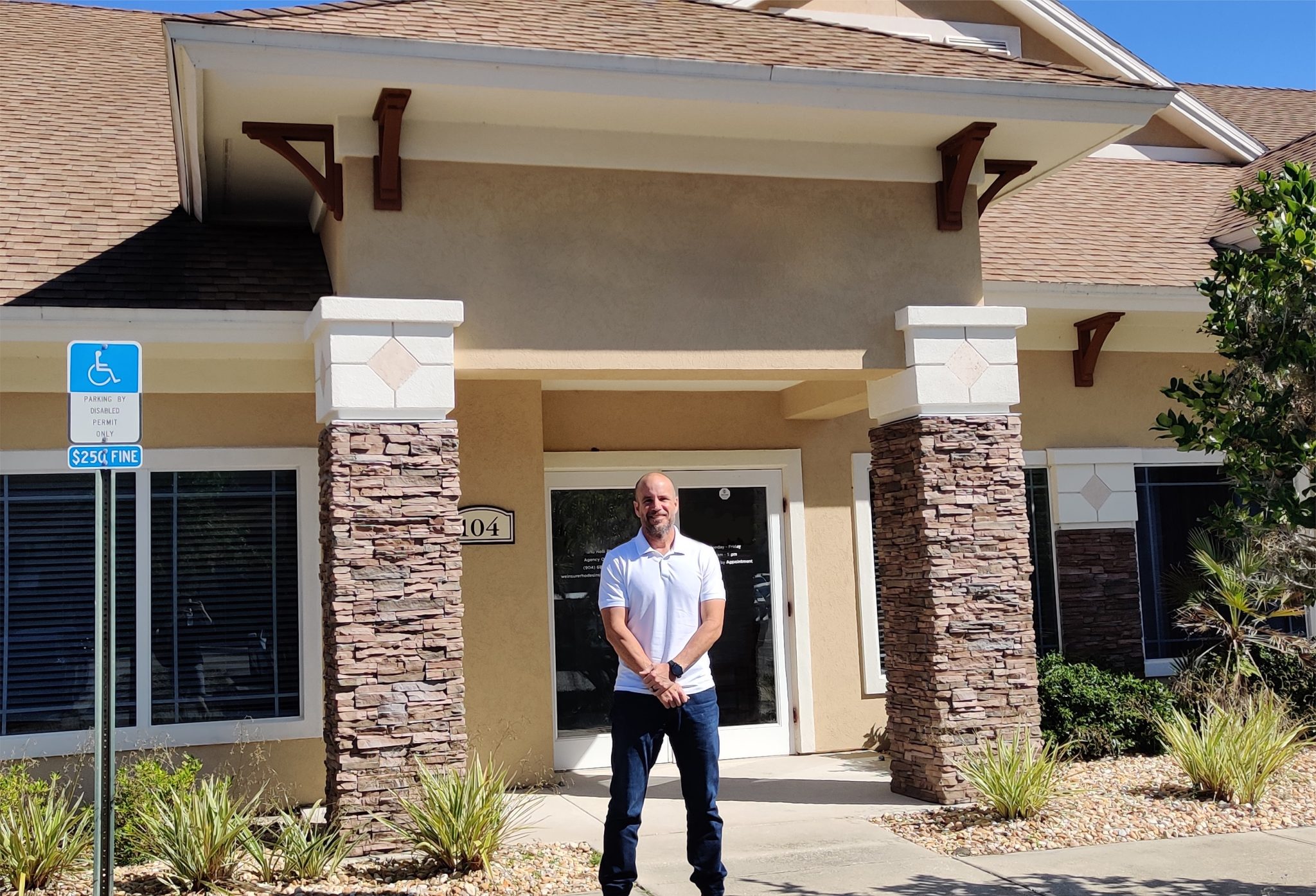
In Person Franchise Visits
Understanding the current state of the Network’s accessibility
- Being in person allowed me to observe users in their own context, giving a good understanding of their day-to-day operations
- Helped create relationships, allowing me to continue dialogue with them after we’ve come back to Belfast
- Being an actual face in front of them built trust with me to share insights and be open and honest about the issues they’re having
Internal Stakeholder Interviews
One-on-one conversations with people who have a vested interest in the success of the product
Key Takeaways
- Content Creation: Adding content is difficult and time-consuming for stakeholders
- Content Discovery: Users struggle to find content, leading to missed info and increased support calls
- Content Relevance: Information is often outdated, reducing trust and usage
- Engagement Visibility: No insight into agent interaction with the network
- Performance Issues: Slow site speed hampers productivity and time management
Verbatim Quotes
- “We want growth, not to be teaching content.”
- “Agents contact us instead of going to the Network because content is hard to find”
- “Just from looking at it, it’s a bit overwhelming.”
- “Agents have a hard time finding what they need.”
- “A positive mindset = a positive seller”
- “The Network is good for someone new in the business”
Franchisee Interviews
One-on-one sessions speaking directly to the franchises, helping us make informed decisions
Key Takeaways
- QRG Trust Issues: Franchisees rely on Quick Reference Guides but lack confidence in their accuracy and usefulness
- Workarounds: Users create their own tools to speed up quoting due to limitations in the network
- Information Overload: Users struggle to find relevant content amid too much noise
- Contextual Relevance: Desire for content tailored to state and role-specific needs
- Knowledge Sharing: Users value peer insights but hesitate to share or ask questions
Verbatim Quotes
- “The idea of the network is great but the platform is not good for what we need it to be”
- “Why doesn’t 1 person update the carrier information rather than 250 people having to figure it out themselves? It’s ridiculous.”
- “This is so outdated, I prefer to go directly to the carrier”
- “I’d change the whole thing, I wouldn’t keep it, dig a hole and bury it, burn it and then let’s just start over fresh”
- “We just save the latest quick reference guides now cos we know they aren’t up to date on the Network”
- “It can take you a few hours to quote a person cos you need to figure out who’s gonna accept it”
- “There’s a lot of extra stuff on there that as an agent I don’t need”
- “Hard to navigate even if you know what you’re looking for”
- “The live chat is off the chain!”
Current effectiveness and usefulness
Current usage of the network
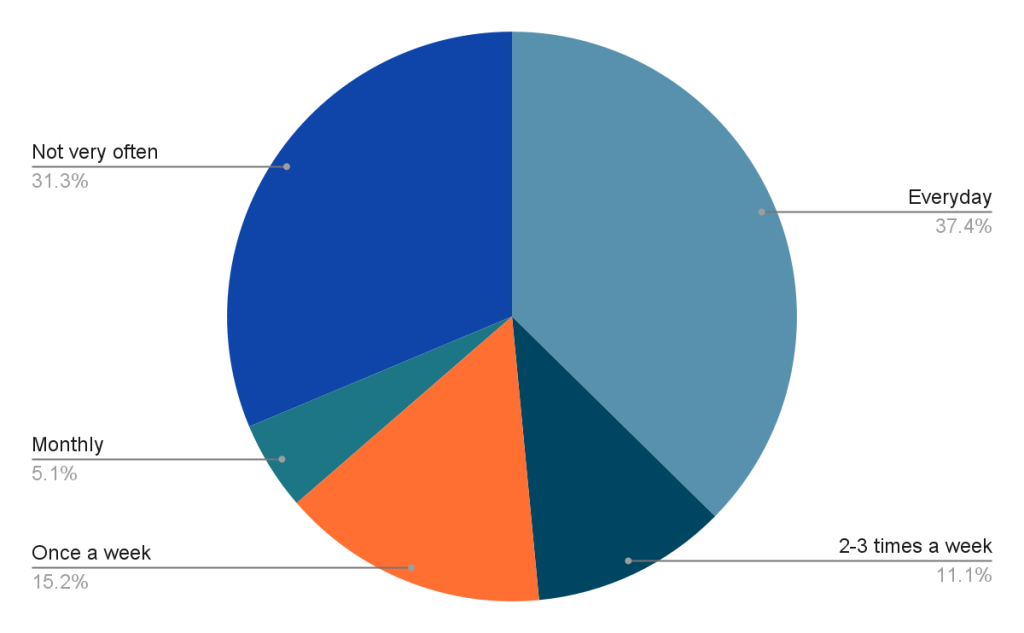
* based on an average of 20 franchises spoken to
Define
Synthesis
At this point I began synthesising all the data gathered. This is the process that brings real value following workshops and interviews. The output is insights that drive the next part in the process, ideation.
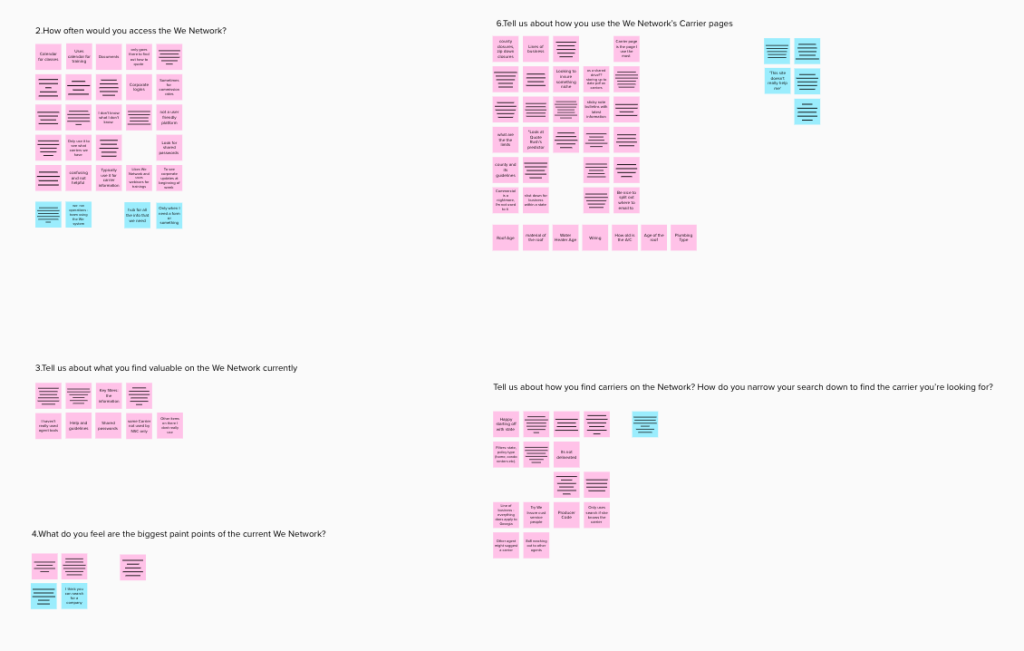
Start with the raw observations, notes, and verbatim quotes
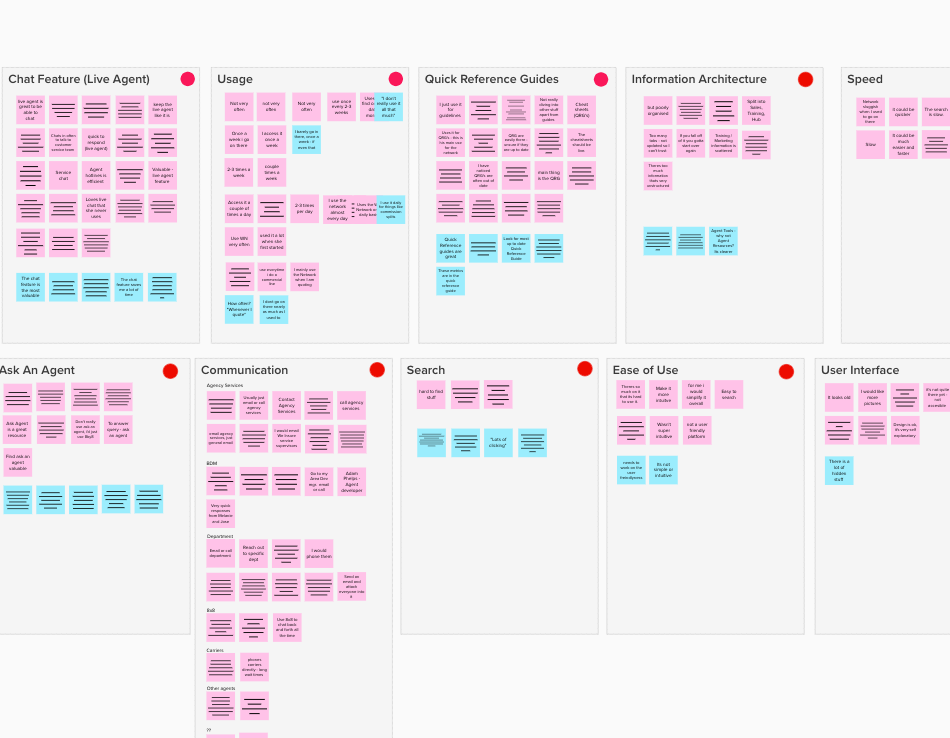
Theme at a high level initially to begin to see patterns form
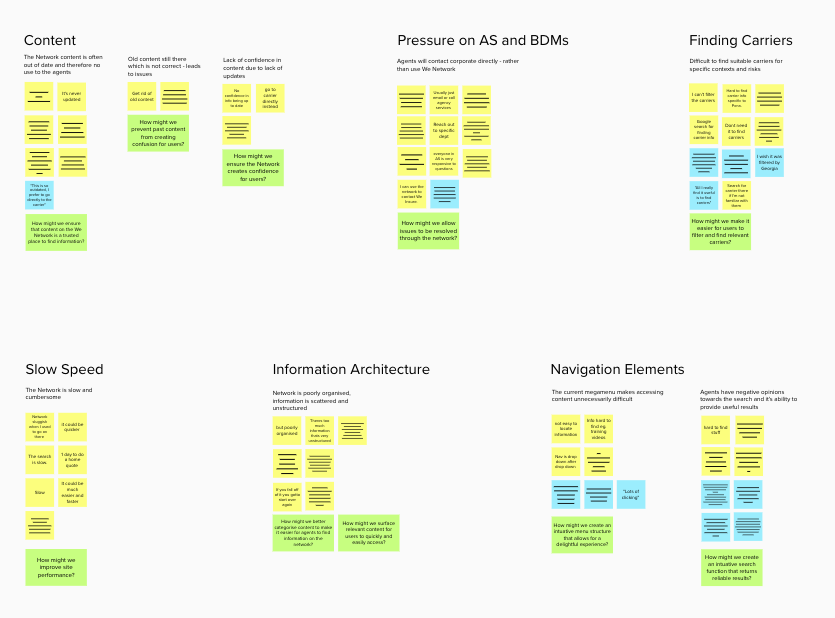
Another round of synthesis brings greater depth of understanding
Allows details to be highlighted and explored
Helpful to present back to teams or stakeholders
Broad strokes show main areas (i.e. Content, Slow Speeds, Pressure on Agency Services etc)
Diving deeper gives in-depth insights
Root Problem Analysis
- Drilling down to grasp the foundational issue at hand in a phase of work
- Achieved through techniques such as the ‘5 Whys’.
There is inherent mistrust in the Network, leaving users to fend for themselves when issues arise
Problem Statement
- Help align a team, ensuring everyone is aware of the focus of the project
- Gives focus on what we want to discover and understand throughout.
The Network exists to help franchises, new and old, self-serve with information and guidance in how to run their franchise. More recently, poor processes and poor quality of resources has meant that much of the information available is outdated or irrelevant.
This causes problems for for new agents coming on and looking for answers to fundamental insurance queries and mature agents looking for specific documentation
because they are receiving incorrect information, reading through outdated documentation, and receiving little to no guidance with everyday issues and queries.
This is important as it reduces their effectiveness as an insurance agent, impacts their reputation as a franchise, and wastes their time having to re-search for the correct information.
User Personas
Taking personas from assumption to accuracy
- Based on real people from our interview sessions
- Used to help make user-centred decisions throughout the project
- Allow us to always re-align to the users when completing QA testing outside of usability testing
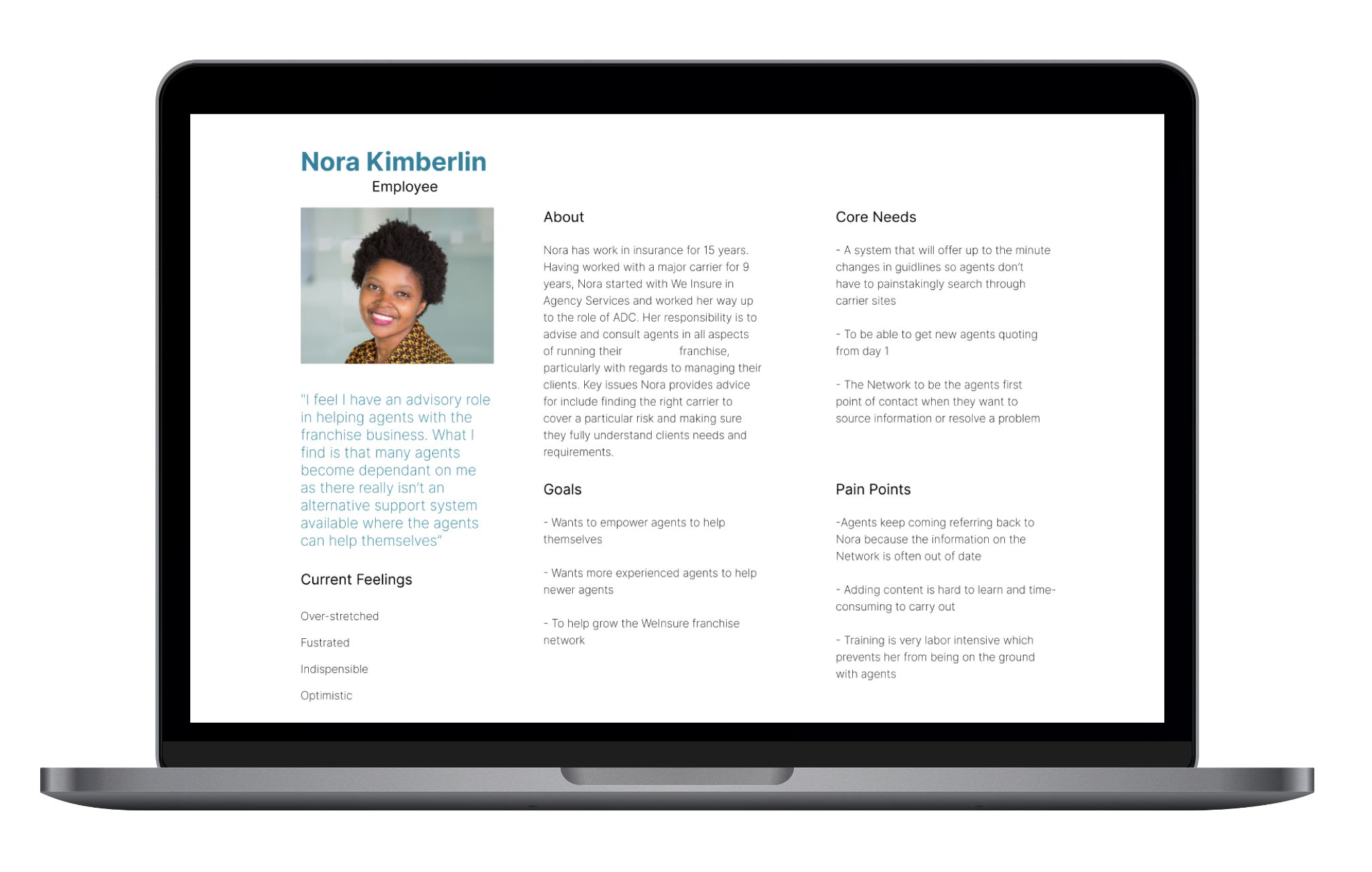
Key Problems to be Solved
The key problems identified in the discovery phase can help guide us to our new proposed solution. From our synthesis, we produce statement starters (some know these as ‘How Might We…’ statements). By challenging ourselves with these statement starters the team remains aligned, progressing in the right direction, always answering the call of the user.
Information Architecture
How might we provide an intuitive navigation that allows for quick access to carriers?
Trust
How might we improve the offering and trust of the Network so that it is an agents first choice for finding carriers?
Performance
How might we improve the users perception of the network by modernising the look and function?
Community + Culture
How might we make this a more comfortable environment for people to ask questions and share expertise?
Goal Definition
Based off the statement starters, produced business goals to be achieved that can relate to the stakeholders
Information Architecture
Eliminate the time wasted struggling to find information
By reorganizing and considering the structure of information, users will be much more self-sufficient when it comes to finding what they are looking for. This results in less strain on corporate answering questions and providing information that is readily available through the network. Through making content intuitive and easy to find, users will be at ease, empowering them to make the best decisions possible.
Trust
Rebuild trust in the Network as the source of information
Unfortunately over the last number of years, users have lost confidence in the network due to outdated information and a lack of dynamic, interesting content. The trust of agents needs to be won back in order to make this the source of information for agents. This can only be achieved through reliable information that is updated regularly, presented in a digestible way, and allows them to best answer the needs of their clients.
Performance
Increase site speed and performance by up to 80%
By increasing site speed and performance, we allow users to access information at their own pace, providing them with data at the touch of a button. A more intuitive search function for both carriers and content makes accessing relevant information almost instant.
Community + Culture
Begin to build and foster a culture that values people who ask questions and share expertise
Users want community, this safe platform allows them to thrive through providing support for each other, growing together, and extending the culture that the organisation prides itself on. By valuing people, the questions and expertise they share, it adds to the success of the Network, giving invaluable insight into areas that may otherwise be missed.
Project Ceremonies
Keeping the process lean whilst providing maximum visibility, keeping stakeholders informed, and the team aligned
Daily multidisciplinary scrum
Daily UX standup
Bi-weekly demos inline with sprint end
Bi-weekly stakeholder review (alternative weeks to demos)
Ideate
Taking everything known and translating into possible solutions




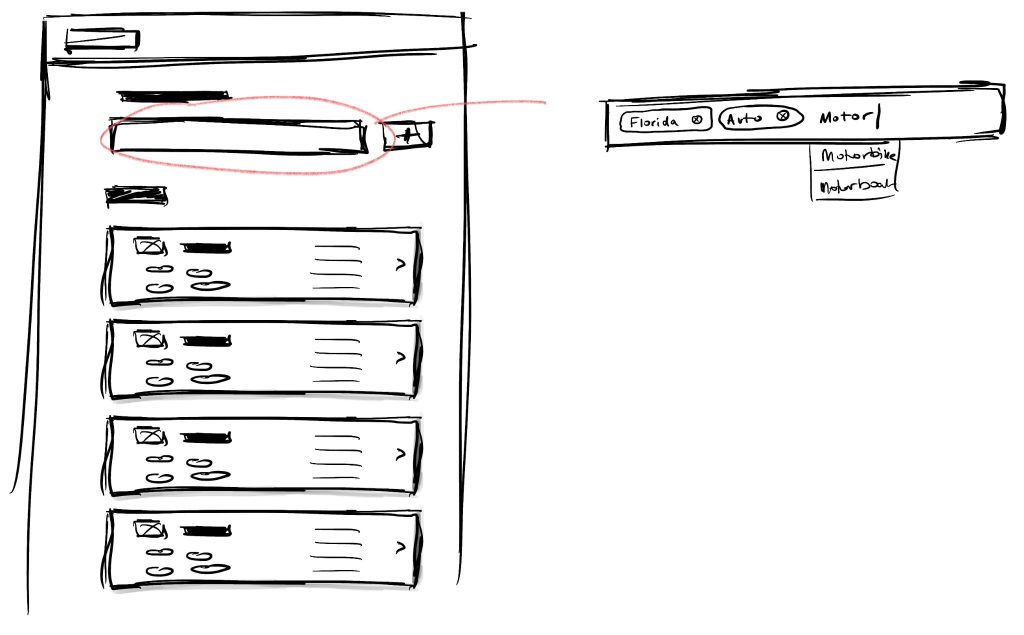
Initial Ideas
- Work through different areas/features/problems systematically making sure nothing is overlooked
- Once an area of focus is selected, start with thinking through what we know so far from our research
- Aligns the people in the session and gives some starting prompts
- Work in collaborative sketching sessions to get ideas and think through creative solutions
- This leads to key priorities, things we like, and other things we need to consider/ask questions about
Prototype
Sitemap + Information Architecture
- Part of producing new products and features is understanding the context
- Look at the architecture and map, understanding where things sit best to create the smoothest experience for users
- Exercises such as card sorting can be used to get feedback from users
- This was used to understand from both internal stakeholder and external users where various pieces of content fitted in
- Open card sorting also gave way for new/overlooked areas to come up
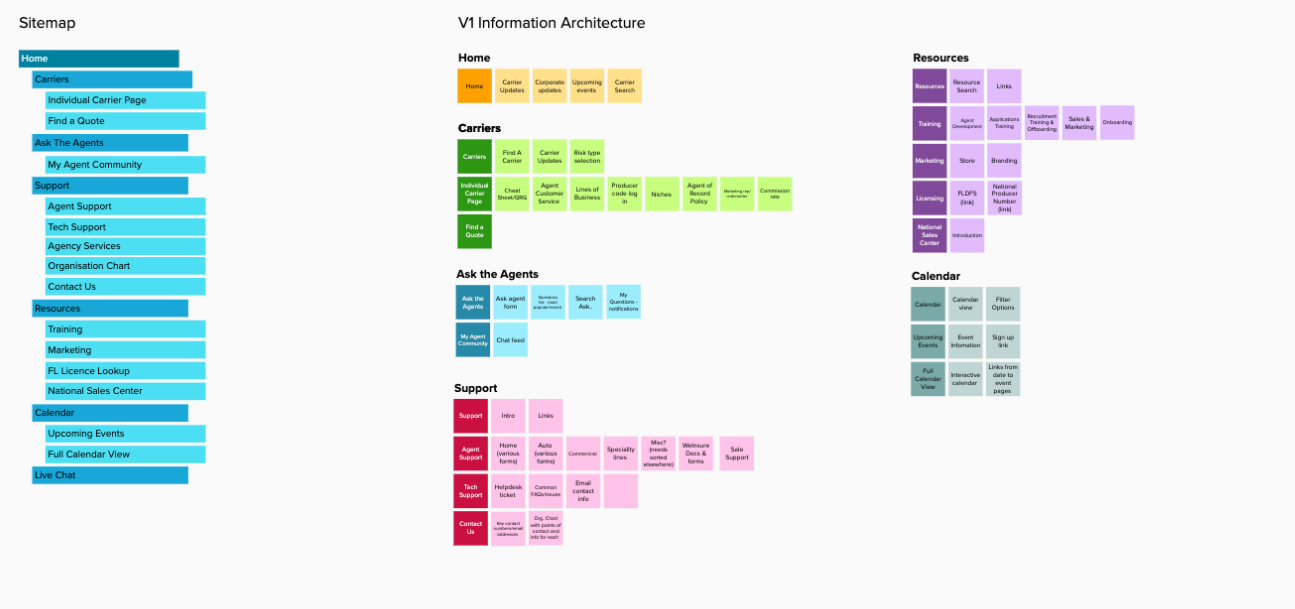
Ideas and sketches into designs, testing at every stage
Took the wireframes and ideas and brought them to life using the design system allowing things to progress quickly.
*Please note, the final designs displayed here are not a true reflection of my current visual design skills, these are simply to help demonstrate my UX process when working on products
Testing
Getting real feedback from real users
Testing occurred at multiple stages throughout the design stage in multiple rounds both with users and during the stakeholder review sessions which took place bi-weekly.
User Design Walkthrough
- Walked users through static designs to gather immediate feedback and observe their understanding of the designed functionality
- Approach is cost-effective since it requires no development work and allows for quick iterations between testing rounds
- At this point in the project, we had to pivot the designs within two days due to a rebrand of the business
Ongoing Usability Testing
- Performed formal usability test sessions after releasing the beta to follow up with users and see first hand how people were experiencing the product
- I had a relationship with every single one of these users from the onsite visits allowing easy and quick access as well as openness and honesty
Implementation
Hands On Testing – Beta Launch
- Got the first iteration of the working product into the hands of users and stakeholders to use and break
- Helps quickly show us where the products pitfalls are
- Includes data from top 49 carriers
- Represents over 90% of premium written
- Has 22 initial users from across various states
User Feedback
Feedback was gathered from users using the newly implemented feedback loop. We need this to understand:
- if we’ve made a positive impact and not broken something good
- what issues there are so we can get a true feel for the experience and begin to iterate and implement fixes/updates/better solutions
“This is a little more clean cut, insanely better”
“Nice and clean, easy to see and find where all of the information is”
“Recently viewed is great, often find myself going back to things”
Agents expected to be able to search more specific terms such as ‘roof age’ and ‘short term rental’
“This search will make it easier than looking using the rater”
“I didn’t know I had to press enter in every key word, but thats easy training”
“Solid, looks great and runs smooth”
“I checked several carriers and noticed the commission tab is missing in them. It was something that was very helpful with the previous version of the network.”
Measurable Additions
Implemented Google Analytics
Implemented HotJar tracking
- To help baseline and measure stats going forward we implemented a couple of products
- Google Analytics was only recently implemented on the old network based off our recommendation meaning there was no reliable long term initial baseline
- HotJar helps us to understand behaviour on the network further and see just how users interact with the network
Achievements
Financial
Saved the business upwards of $4M each year
Increase of $300M of premium written annually
Agents annual commission increased by up to $150,000
Business
Thrive, not survive
Enabled Business Development Managers to focus on on bringing value, not gathering basic information
Out with the old, in with the new
Facilitated the timely communication of new/emerging information, cutting out 100% of contradictory data
Restoration of trust
Allowed franchises to focus on closing deals not finding documents
Initial GOals
Information Architecture
Eliminate the time wasted struggling to find information
- Designed and built a custom carrier search that allowed agents to filter down carriers based on common terms and aspects of insurance
- Reduced noise and amount of content presented on screen to users, allowing key information to stand out and become clearer
- Global search feature giving users clear results and an ability to filter by content type (i.e. news, carrier, page, event, etc)
- Created new site structure to make navigating to information more streamlined and intuitive based on multiple usability test sessions
Trust
Rebuild trust in the Network as the source of information
- Prioritised states and carriers to create a content plan in order to gather the relevant information for each carrier page
- Started with a fresh database, not migrating in old, out-of-date information from the old Network to prevent erroneous data being presented
- Created rigid page templates where necessary that allow for easy updates to be made with the CMS across the site
- Formatted the CMS to allow for new pages to be added when required. These page elements are branded and deigned to fit in with the rest of the network with no modification necessary
Performance
Increase site speed and performance by up to 80%
- Increased site performance by over 1300% (based on Google lighthouse testing)
- Removed unnecessary plugins that the previous network included
- All colours, content, and layouts are accessible, with a minimum of AA compliance
- Entire network is now designed an built responsively, allowing users to access across multiple devices and receive the exact same experience
- SUS (System Usability Scale) score of 90 (above 68 is considered above average)
Community + Culture
Begin to build and foster a culture that values people who ask questions and share expertise
- Engaged numerous franchises and internal stakeholders to build relationships, garnering trust and shared ownership of the Network
- Provided a feedback loop, allowing new ideas and suggestions to be surfaced to internal owners
- Provided a platform and gave advice to help internal stakeholders engage with franchises to better understand user needs
- Built in a new, clearer Ask an Agent feature allowing the community to continue working together to help one another
Challenges
Carrier Data Scope
Solved by prioritising gathering data from top carriers covering 90% of premiums written by agents
Sustainability
Addressed by building custom templates so staff can update content without devs
Trusted Source
Built relationships with franchises, frequently engaging with and listening to them
